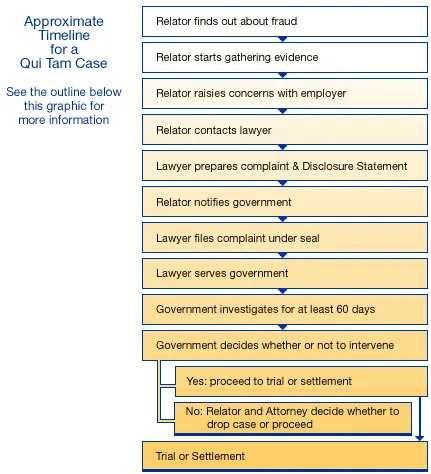|
There is no guarantee that any qui tam case will be successful. But even in a successful case, results can be a very long time in coming. It is not unusual for a settlement to be reached only after years of investigating on the part of the government.
Although each case will be different, the outline below shows the steps that a typical health care qui tam case will go through from the time the whistleblower discovers the fraud up until the government decides whether to intervene. If the case is not settled at that time, then several additional years of litigation and appeals can be expected.

Qui Tam Procedure Outline for a Health Care Case
-
Relator finds out about ongoing fraud.
-
Relator assesses the magnitude of fraud.
- Gather as much documentary evidence as possible
- Do not steal documents
- Create records of how documents were obtained if risk that confidentiality/theft of documents will be an issue
- Create a journal documenting meetings, relevant statements, etc.
-
Consider raising concerns with employer in order to come under the False Claims Act whistleblower protection, Section 3730(h) and/or other applicable whistleblower protection provisions. Discuss with lawyer.
-
Consider raising concerns with employer in order to ensure that relator’s perception of fraud is correct (there may be a valid explanation/rationale for the suspect procedures.) Discuss with lawyer.
-
Relator should not discuss the matter in public or disseminate information about the matter in order to avoid public disclosure issues and/or a preemptive qui tam action by a co-worker or others.
-
Contact a lawyer:
- Lawyer should instruct client on applicable law so that client will be sensitive to events when they occur.
- Lawyer should direct client on additional steps necessary for a successful action.
- Lawyer should instruct client on likely consequences to reputation, ability to obtain employment, likelihood of success, possibility of lawsuits against client for defamation, tortious interference, etc.
- Before taking case, lawyer should assess:
- Degree of knowledge by potential relator.
- Amount and nature of relator’s documentary evidence.
- Relator’s determination and ability to stomach case/see it to completion, as evidenced by:
- Amount of documentary evidence
- Nature and frequency of complaints by relator to employer
- Trustworthiness and reliability of relator
- Relator’s motives
- Likely weight that government will assign to relator’s story
- Relator’s position in the corporate hierarchy
- False Claims Act law.
- Intermediary letters
- Advisory opinions
- Clarity of rules
- Case law
- Any other materials
- Extent of fraud: national corporation vs. local entity.
- Existence of a national or regional initiative; similar pending cases
- Check with TAF/TAFNET
- Call HCFA
- Review periodicals/journals
- Surf the net
- Other counsel
- Position of local U.S. attorney’s office regarding case
- Telephone conference
- Personal interviews/meetings
-
Lawyer prepares complaint
- Determine federal causes of action available.
- False Claims Act
- Stark legislation
- Omnibus Protection Act (nursing homes)
- Anti-kickback statutes
- Determine existence of analogous state law
-
Lawyer prepares disclosure statement, usually containing
- Confidentiality/Privilege statement/issues
- Legal background/specific laws violated
- Factual background
- Include percentage of Medicare/Medicaid revenues
- Emphasize liability of corporate entities vs. individual defendants
- Witnesses
- Exhibits
-
Notify government to protect "original source" exemption.
-
Determine local federal district court’s seal procedures and file complaint under seal:
- Educate clerk of court about secrecy of action.
- Go to judge’s chambers and obtain seal order
- Judge will place all documents to be filed in a sealed envelope, which lawyer is to file with the clerk. Reemphasize again secrecy requirement. Ask clerk to deposit envelope in vault in your presence.
- Lawyer must have originals or copies of everything before envelope gets sealed.
- Disclosure statement does NOT get filed in court.
-
Lawyer or law firm employee delivers disclosure statement to local U.S. attorney’s office together with copies of documents filed with the court.
-
After case number and judge assigned to case, serve copies of disclosure statement on DOJ, as well as copies of documents filed with court.
-
Provide copies of everything to relator with letter outlining what will likely happen in the future.
- During sixty day initial seal period:
- Government communication unlikely during first sixty days
- At end of sixty-days, Government will likely ask for six-month extension of seal.
- At end of sixty-days, Government will likely ask for meeting with relator and relator’s counsel.
- Government likely review of case during seal:
- DOJ reviews
- DOJ will take lead only if national matters.
- DOJ will submit the case to the Department of Health and Human Services ("HHS"), Office of the Inspector General ("OIG") for its review.
- OIG will assign review of the case to a unit in charge of area in question.
- Other government actors involved in review are local United States Attorney’s office, FBI, and HHS.
- Government’s decision to intervene or to decline intervention made at end of six-month extended period, unless seal renewed once again.
-
If Government ultimately declines to intervene:
- Investigate through FOIA whether government is pursing matter through alternative administrative avenues.
- Monitor alternative procedures
- Claim reward if there is administrative recovery, pursuant to False Claims Act, Section 3729(c)(5).
- Relator and lawyer need to discuss future of case.
- Private Prosecution
- Drop case
|